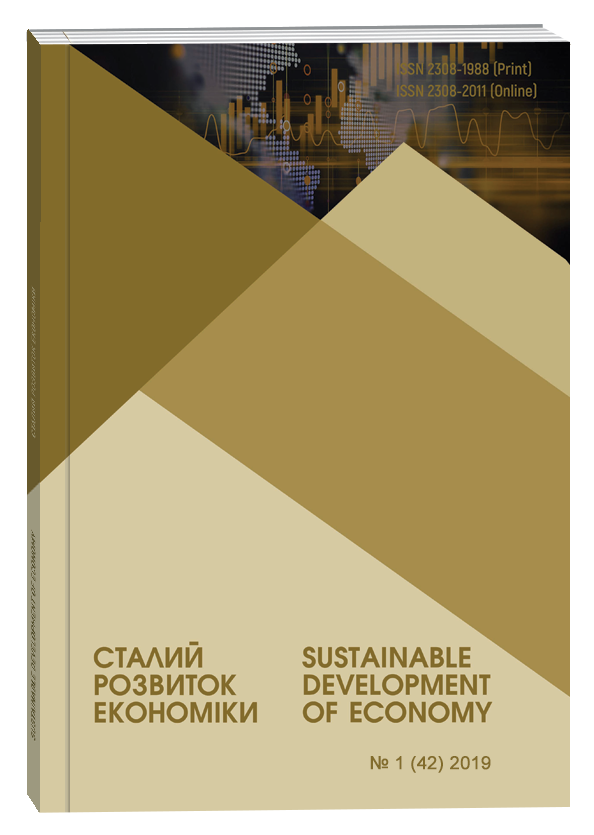THE ASSESSMENT OF THE RURAL AREAS SUSTAINABLE DEVELOPMENT
Abstract
Purpose. The goal of the research is to work-out the recommendations concerning the implementation of the indicators system, which should be applied for the economic assessment of the rural areas sustainable development, and for the grounding of measures to improve the rural areas efficiency. Methodology of research. The research methodological basis is the latest scientific achievements concerning the sphere of the rural areas sustainable development. The following methods were used to achieve this goal: morphological analysis (in the processing of scientific publications regarding the rural areas sustainable development); economic-statistical and comparative analysis (in cases of the economic assessment of the rural areas sustainable development); analogy and generalization methods (in cases of grounding of the indicators system, which should be applied for the economic assessment of the rural areas sustainable development and for the improvement of the rural areas development effectiveness as well). Findings. On the basis of the proposed indicators, the author took the economic assessment of the rural areas sustainable development that illustrated the not effective realization of the existing ecological and economic potential. The study period is 2014-2017th. On the basis of the obtained results it was concluded that the possibilities of the natural-resources potential using for sustainable development are taken into account not enough. There were represented the indicators that should be used for the economic assessment of rural areas sustainable development and taken into account in the framing of the rural areas development plans. Such the indicators include: the general endowment of agricultural lands, the crop and livestock production per 100 hectares of agricultural lands, the ploughings of agricultural lands, the proportion of intensive crops in the crops structure, the level of profitability, the dynamics of revenue and profits from sales, costs per unit land area, analysis of the existing material and technicalresources for the rural areas development and the ways to its renewal. The application of these indicators will reveal the causation and incidence of the land-resource potential using, for intensification of the rural areas internal potential for its economic growing. There were proposed the main ways of improving the rural areas efficiency, such as: a detailed and comprehensive analysis of the current state of rural areas use; agricultural production true to the sustainable development principles; prognoses of the state of land-resource potential using; stopping degradation processes; introducing investment and innovation processes within the framework of diversification of the rural areas economic development. Originality. There were grounded the indicators system, which should be applied for the economic assessment of the rural areas sustainable development, and ways to improve of the rural areas development effectiveness as well. Practical value. The obtained conclusions and recommendations, theoretical and methodological approaches based on the research results can be used by land surveying and land valuation organizations, executive authorities and local self-government bodies and other persons or companies to assess the rural areas sustainable development.
References
Котикова О.І. Економічні індикатори сільськогосподарського землекористування в системі моніторингу сталого розвитку України. Агросвіт. 2017. № 9. С. 3-11.
Карпінський Б.А. Сталий розвиток економіки: узагальнена модель: монографія. Львів: Вид-во «Логос», 2005. 256 с.
Бойко Є.О. Передумови переходу України до концепції сталого розвитку. Економічний простір. 2014. № 77. С. 239-249. URL: http://nbuv.gov.ua/UJRN/ecpros_2014_77_25 (дата звернення: 01.11.2018).
Lynam J.K., Herdt W.R. Sense and sustainability as an objective in international agricultural research. Agricultural Economics. 1989. № 3. P. 381-398.
Peri C., Dumanski J., Hamblin A.S., Young A. Land quality indicators. World Bank Discussion Paper. 2005. No. 315. World Bank, Washington D.C. 25 p. URL: http://documents.worldbank.org/curated (дата звернення: 22.11.2018).
OECD. Environmental indicators for agricultural. OECD Publication, Paris, 1997. 400 p.
Волков С.Н., Хлыстун В.Н., Улюкаев В.Х. Основы землевладения и землепользования. Москва: Колос, 1992, 144 с.
Другак В.М. Теоретичні і методичні основи економіки землекористування. Київ: ЦЗРУ, 2004. 150 с.
Україна у цифрах у 2017 році: статистичний збірник / За ред. Вернера І.Є. Київ: ТОВ «Видавництво «Консультант». 240 с.
Сморжанюк Т.П. Сталий розвиток в умовах глобалізації та його складові. Економічні інновації. 2013. Вип. 53. С. 253-260.
Добряк Д.С., Тихонов А.Г., Гребенюк Н.В. Теоретичні засади сталого розвитку землекористування у сільському господарстві. Київ: Урожай. 2004. 136 с.
Основні економічні показники виробництва продукції сільського господарства по сільськогосподарських підприємствах: статистичний бюлетень. Форма № 50-сг. URL: http://www.ukrstat.gov.ua (д1. Kotykova, O.I. and Bohoslavska, A.V. (2017), “Economic indicators of agricultural land-tenure are in the system of steady development of Ukraine”, Ahrosvit, no. 9, pp. 3-11.
Karpinskyi, B.A. and Bozhko, S.M. (2005), Stalyi rosvytok ekonomiky: uzahalnena model [Sustainability development of economy: the generalized model], monograph, Vyd-vo «Lohos», Lviv, Ukraine, 256 p.
Boiko, Ye.O. (2014), “Pre-conditions of transition of Ukraine are to conception of steady development”, Ekonomichnyi prostir, no. 77, pp. 239-249, available at: http://nbuv.gov.ua/UJRN/ecpros_2014_77_25 (access date November 01, 2018).
Lynam, J.K. and Herdt, W.R. (1989), “Sense and sustainability as an objective in international agricultural research”, Agricultural Economics, no. 3, pp. 381-398.
Peri, C., Dumanski, J., Hamblin, A.S. and Young, A. (2005), “Land quality indicators”, World Bank Discussion Paper, no. 315, World Bank, Washington, USA. 25 р., available at: http://documents.worldbank.org/curated (access date November 22, 2018).
OECD (1997), Environmental indicators for agriculture. OECD Publication. Paris, 400 p.
Volkov, S.N., Khlystun, V.N. and Uliukaev, V.Kh. (1992), Osnovy zemlevladeniia i zemlepolzovaniia [Basics of land tenure and land use], Kolos, Moscow, Russia, 144 p.
Druhak, V.M. (2004), Teoretychni i metodychni osnovy ekonomiky zemlekorystuvannia [Theoretical and methodological foundations of land use economics], TsZRU, Kyiv, Ukraine, 150 p.
Verner, I.Ye. (2018), Ukraina v tsyfrakh u 2017 rotsi [Ukraine in figures in 2017]: statystychnyi zbirnyk [statistical collection], TOV «Vydavnytstvo «Konsultant», Kyiv, Ukraine, 240 p.
Smorzhaniuk, T.P. (2013), “Sustainability development in the conditions of globalization and his constituents”, Ekonomichni innovatsii, Iss. 53, pp. 253-260.
Dobriak, D.S., Tykhonov, A.H. and Hrebeniuk, N.V. (2004), Teoretychni zasady staloho rozvytky zemlekorystuvannia v silskomu hospodarstvi [Theoretical principles of sustainable development of land use in agriculture], Urozhai, Kyiv, Ukraine, 136 p.
Osnovni ekonomichni pokaznyky vyrobnytstva produktsii silskoho hospodarstva po silskohospodarskykh pidpryiemstvakh [Basic economic indicators of production of goods of agricultural enterprises], available at: http://www.ukrstat.gov.ua (access date October 17, 2018).


